|
Leadership Message
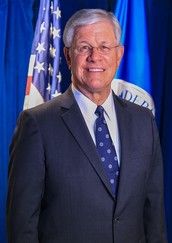
National Preparedness Month is a time set aside to promote family and community disaster planning. Preparing for the unexpected is vital. One aspect of preparedness I’d like to talk about today is flood insurance.
Every FEMA employee is an emergency manager. Your work executing the agency’s mission of helping people before, during and after disasters can, and should, extend to your personal preparedness.
You may think that you need to live near the water to be at risk of flooding, but where it can rain, it can flood. In fact, flooding can happen anywhere at any time and is the most common and costly disaster in the United States.
Consider the cost of flooding to your home: just one inch of water in your home can cause up to $25,000 in damages. Many people mistakenly assume their home-owners insurance is enough, however it does not cover the cost of repairing flood damage.
Further, federal disaster assistance isn’t intended to restore personal properties to pre-disaster conditions. The difference between what an uninsured versus insured individual might receive following a disaster is striking. Following Hurricane Michael in 2018, the average FEMA grant to Florida's uninsured survivors was approximately $4,500; the average payment to a flood insurance policy holder was more than $68,000.
Protect the life you’ve built: your insurance company or agent can give you more information about the right coverage for you. To learn more about the value of having flood insurance, visit FloodSmart.gov.
David Maurstad
Flood Insurance and Mitigation Administration,
Deputy Associate Administrator
|
We Are FEMA
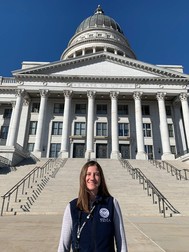
Jennifer Laack is a Training and Exercise Specialist in Utah as part of the Region 8 Field Integration Team.
She relocated to Utah to support a training and exercise program to increase preparedness to respond to a catastrophic earthquake on the Wasatch Fault in Utah.
“The best part of my job is working with a team that embraces innovation. Each disaster teaches us lessons to improve our responses for future disasters. Being able to identify areas for improvement and create solutions with local and sometimes national impacts is extremely rewarding.” Jennifer said.
FEMA Weekly is accepting submissions about FEMA employees across the agency who embody our core values of compassion, fairness, integrity and respect while they execute the FEMA mission. Send stories to FEMA-Employee-Communications@fema.dhs.gov. Submissions should be 100 words or fewer, outlining the employee’s role at the agency, how/who/why they help, a personal anecdote and a high-resolution photo of them. We will contact you if your submission is selected to be profiled. Please indicate if the article subject does NOT want their profile to be released to the general public.
|
Program News
 The Office of Personnel Management will launch the annual Federal Employee Viewpoint Survey (FEVS) on Sept. 24. The survey will be available for a six-week period closing on Nov. 5. Permanent and temporary full time, excepted service, CORE and reservist employees will receive the survey at the same time.
FEMA leaders at all levels value your input, so employees are encouraged to complete the survey. Your participation is strictly voluntary, and your responses are confidential. Whether you are providing positive feedback or recommending areas for improvement, or both, your feedback is important! Your participation in this survey ensures all perspectives on our FEMA workplace are included so we can improve our culture and continue to accomplish our mission.
If you have additional questions, send an email to the Human Capital Service Desk.
FEVS is a government-wide survey that allows FEMA and other federal agencies to capture employee perspectives of workplace culture and overall workplace satisfaction. This year’s survey includes specific questions about work during the COVID-19 pandemic.
September is National Preparedness Month. Each week, FEMA Weekly will focus on a new theme to encourage personal and family preparedness. This month, commit to taking a new preparedness action each week to be best prepared for the unknown.
After an emergency, you may need to survive on your own for several days. Being prepared means having your own food, water and other supplies to last for several days for each person in your home. An emergency supply kit is a collection of basic items your household may need in the event of an emergency or available “to go” if you must evacuate in a hurry.
Make sure your emergency kit is stocked with essential items, including having items that can protect you and your family from coronavirus (COVID-19) disease, such as masks, hand sanitizer, and other items recommended by the Centers for Disease Control and Prevention (CDC). Store items in airtight plastic bags and put your entire disaster supply kit in one or two easy-to-carry containers, such as plastic bins or a duffel bag. Also, consider unique needs of each member in your household, such as supplies for seniors, individuals with disabilities, and even pets. For families with infants, be sure to include formula, bottles, diapers and wipes.
By having an emergency supply kit with essential items, you can be better prepared, no matter where or when disaster strikes. Start building your kit today! Visit Ready.gov/Kit for more information.
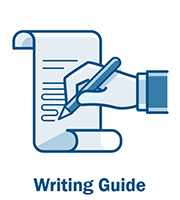
In February, the Office of External Affairs (OEA) debuted a new FEMA Branding intranet site. The site includes new guidelines and tools for employees. These tools include a design style guide, guidance on co-branding and logo usage and templates for a standard email signature block, PowerPoint presentations, fact sheets.
Last week, OEA posted the FEMA Writing Guide for use by all employees. The guide is a tool to ensure that all agency written products are created in a clear, cohesive style, using plain language that reflects FEMA’s core values. The writing guidelines help us produce products that are customer focused, build a common understanding for the appropriate audience and present a consistent narrative about the agency.
Use this guide when you are creating written products for the public -- such as internal or external newsletters -- letters to FEMA program applicants, or articles for media publication and additional external audiences.
The style guide does not replace the U.S. Government Publishing Office Style Manual and the Office of the Executive Secretariat Instruction Manual for official FEMA publications or executive-level correspondence.
The guide also addresses where FEMA departs from Associated Press (AP) Style in some areas when writing products for public use.
The guide provides additional writing guidance including:
- Overview of plain language and use of FEMA voice.
- Appendix of AP Style rules for states, datelines and addresses.
- Appendix of AP Style rules for military titles.
- Appendix of commonly misused terms.
|
September is National Insider Threat Awareness Month. An insider threat is when someone with access to government assets uses their authorized access, wittingly or unwittingly, to harm the security of the United States.
This year's theme is "Resilience: the intangible quality allowing us to face adversity and bounce back." It is important for FEMA personnel to maintain personal well-being and sound mental health to be resilient and aware of insider threat indicators.
Take time this month to complete the annual required DHS Insider Threat Awareness training in the FEMA Employee Knowledge Center (FEKC).
For additional information go to the Office of the Chief Security Officer Insider Threat Awareness Page or send an email to FEMA-OCSO-SCD-InsiderThreat@fema.dhs.gov.
Department of Homeland Security (DHS) approved FEMA to waive the biweekly premium pay cap for applicable employees who performed authorized overtime for Hurricane Laura.
The biweekly waiver applies only to work performed in connection with the specific event and its aftermath and is limited to the following event and timeframe:
- Hurricane Laura.
- 2020 Pay Periods 17 through 26.
Payment processing, timekeeper reminders and the employee notice are included on the Premium Pay Cap Waivers site.
If you have any questions or need assistance regarding the approved waiver, send an email to Office of the Chief Component Human Capital Officer Payroll and Compensation Team.
The Office of the Chief Information Officer (OCIO) recently published the "FEMA Information Technology (IT) Strategic Implementation Plan," which is a complement to the "FEMA IT Strategic Plan for Fiscal Years 2020-2024." The plan outlines OCIO-led initiatives to achieve the agency’s IT goals and objectives and will be updated annually. The plan will promote long-term organizational maturity and building a culture of shared responsibility to achieve IT excellence as One FEMA IT.
OCIO looks forward to continued coordination and collaboration with key partners across the agency to ensure the plan’s success. Additionally, OCIO welcomes input to fully empower FEMA’s workforce through IT. OCIO will also continue to regularly share information on IT initiatives with stakeholders, including through the IT Governance Board and executive officers and business managers.
For additional information, visit the OCIO intranet site. Questions or input on IT initiatives should be emailed to OCIO’s Customer Relationship Managers.
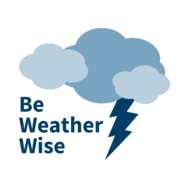
Have you ever heard a weather term used and wondered what it meant? Curious about unusual weather phenomena?
This week, FEMA Weekly launches a new occasional series, Be Weather Wise. We'll use this space to answer some questions and teach everyone more about the weather in a fun and engaging way.
Today's Be Weather Wise is about derechos.
|
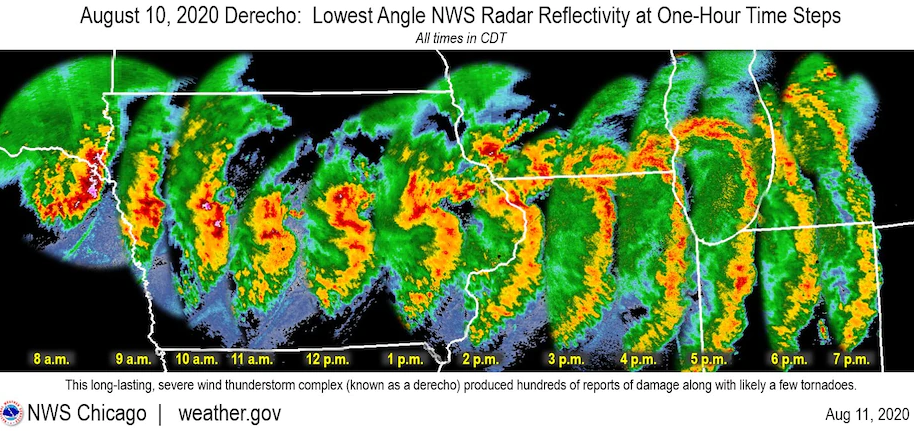 On Aug. 10 a derecho swept across a large area of Iowa, causing damage to homes, agriculture, businesses and utilities across 16 counties. Wind gusts reached up to 140 mph, which is equivalent to a category 4 hurricane. This destructive event introduced many people to a weather term they had not heard in the past: derecho.
What is a derecho?
A derecho is a long line of continuous, intense thunderstorms packed with powerful winds travelling hundreds of miles intact. This complex line of thunderstorms must travel a minimum distance of 240 miles or more with wind speeds over 58 mph and gusts of 74 mph or greater to be considered a derecho.
Although a derecho can produce destruction similar to that of a tornado, the damage typically occurs in one direction along a relatively straight swath. As a result, the term "straight-line wind damage" sometimes is used to describe derecho damage. Hence the name “derecho,” which is derived from the Spanish word meaning “straight.”
Additional hazards associated with a derecho include weak embedded tornadoes, heavy rainfall and hail. Impacts from a derecho include significant widespread power outages, falling and flying tree debris, as well as the potential for structural damage. They are very difficult to predict in advance and are generally only known to be occurring once they are ongoing.
How common is a derecho?
Forming mainly in the late spring and summer, derechos can form when there is the threat for organized thunderstorm development over a large area. However, not every cluster of thunderstorms will form a derecho. While a derecho is not uncommon, there are areas in the United States that are more likely to experience these destructive events.
The state of Iowa received a Major Disaster Declaration for the derecho on Aug. 18. Ten counties were approved for Individual Assistance and 16 counties were approved for Public Assistance.
The Hatch Act prohibits federal employees from soliciting, accepting or receiving political contributions at all times. Even when an employee is off duty and away from the workplace, they may not fundraise for a political party, candidate for partisan political office or partisan political group.
Some examples of prohibited fundraising under the Hatch Act include:
- Sending or forwarding an email that solicits political contributions, even when at home and off duty
- Inviting others to political fundraising events
- Hosting or being the point of contact or sponsor for a political fundraising event
- “Liking,” “sharing” or “retweeting” a solicitation to donate or an invitation to a partisan political fundraising event on social media.
Please note that the Hatch Act does not prohibit a federal employee themselves from contributing to a partisan political candidate, party or organization. Additionally, federal employees can only do so when off duty and outside the federal workplace.
If you have any questions, send an email to FEMA Ethics at FEMA-Ethics@fema.dhs.gov.
News You Can Use
All full-time employees will receive a Training Needs Assessment survey from FEMA’s Training, Education, and Professional Development Council (TEP-C) by email. The survey is being distributed to employees on a staggered schedule, so not every employee will receive it at the same time.
Designed to assist in assessing the current state of FEMA workforce training, survey results will be used to guide the TEP-C in proposing changes to FEMA’s training enterprise. Survey participants will share their views on the current state of FEMA training to inform improvements to address their training needs.
Employees will have five days to complete the survey.
Reservist training needs are assessed through the Field Operations Directorate and their cadre management.
For additional information please send an email to the TEP-Council Training Needs Assessment integrated project team.
FEMA’s Training, Education and Professional Development Council (TEP-C) is chartered under the Human Capital Governance Board to strengthen the agency’s mission by delivering exceptional training, education and professional development to employees.
Join the Alternative Dispute Resolution Division from 1 – 2 p.m. ET on Sept. 16 for this training that provides useful tools enabling you not only to manage a difficult conversation in a constructive way, but also help transform an adversarial situation into an opportunity for a better workplace relationship. The Zoom meeting can accommodate up to 300 participants.
Join ZoomGov Meeting: https://fema.zoomgov.com/j/1611980619
- Meeting ID: 161 198 0619.
- Password: 771485.
For further participation details, see the Sept. 2 edition of FEMA Weekly.
The DHS Office for Civil Rights and Civil Liberties is holding the virtual course: Racism, Micro-Inequities, and Micro-Affirmations in the Workplace.
This course will provide guidance about when and where to initiate difficult conversations on race, equality and micro-inequities. The webinar will outline the benefits of having these conversations and help enable participants to move toward affirmations that improve the work environment for all.
The webinar will be held at 10 a.m. ET on Sept. 9. Visit DHS Adobe Connect to register.
The Office of the Chief Learning Officer reminds everyone that the following required training classes have an upcoming Sept. 30 due date:
- Preventing and Addressing Workplace Harassment.
- FEMA Human Trafficking Awareness.
- IS-0038.20: Fraud Awareness and Prevention.
- IS-907: Active Shooter: What You Can Do.
If your transcript shows any of the course completion dates before Oct. 1, 2019, you must complete the training again.
To complete these courses, log into FEMA Employee Knowledge Center (FEKC) and use the Search Training Catalog box on the right side of the screen for the course.
Please review the 2020 Mandatory Training Matrix to see other mandatory trainings and associated completion dates required of FEMA employees and contractors.
For questions, send an email to the FEKC Help Desk.
 Visit the FEMA Forward redesigned Intranet site that provides employees with an improved central location for COVID-19-related updates and critical information and resources on:
The page is designed to ensure that you have the latest information about what FEMA is doing, what you can do and available resources. If you have questions or suggestions, please send an email to FEMA-COVID19@fema.dhs.gov.
Reservist Connection
Dear RABy is a question and answer feature the Reservist Advisory Board (RAB) uses to address questions from reservist employees. Do you have a question for the Reservist Advisory Board other ideas/examples from previous deployments that you thought really helped? Send it to FEMA-RAB@fema.dhs.gov and it may be featured in an upcoming FEMA Weekly.
 |
|
Does FEMA offer a long-term care benefits option for the reservist workforce?
|
Yes, reservists have the option to enroll in the Federal Long-Term Care Insurance Program (FLTCIP) which is sponsored and regulated by the U.S. Office of Personnel Management and a private sector insurance company.
The FLTCIP helps pay for long term care services from your choice of caregiver in a variety of settings such as in home or facilities such as an assisted living facility, adult daycare or a nursing home. The FLTCIP has a stay-at-home benefit that includes a range of services that support care in your home, helping you maintain your quality of life in familiar surroundings.
You do not have to wait until you are deployed to enroll. The FLTCIP is portable and guaranteed renewable, which means you can continue to keep your coverage as long as you pay your premiums!
For more information on webinars, plans and enrollment, visit the FLTCIP website or call 1-800-LTC-FEDS (1-800-582-3337).
Please visit the Reservist Advisory Board Page for the most up-to-date information related to RAB activities.
A cadre coordinator oversees all aspects of day-to-day cadre management including staffing, equipping, training, qualifying and performance of the cadre and its members. Visit the FEMA intranet home page for a list of FEMA cadre coordinators.
In Memory
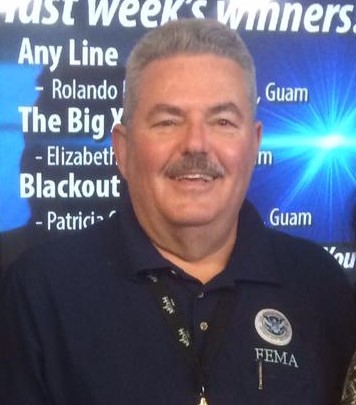
Former Region 9 External Affairs Director John Hamill passed away on Sept. 1, after contracting COVID-19 in August.
Hamill joined FEMA in 2009 after a long and storied career including public relations for the New York City Housing Authority, a columnist for the New York Daily News and a writer at the Los Angeles Herald Examiner, the Boston Herald American, Rolling Stone magazine and the Village Voice. Hamill also co-authored a pair of Hollywood screenplays: “Turk 182!,” starring Timothy Hutton in 1985, and “Critical Condition” with Richard Pryor in the lead in 1987.
Hamill was a decorated Army veteran who served in Vietnam with the 173rd Airborne as a combat medic, surviving two helicopter crashes and bullet wounds during the Tet Offensive which earned him a Bronze Star and a Purple Heart.
A native of Brooklyn, New York, Hamill was known for his encyclopedic knowledge of his beloved New York Mets and uncanny capacity for knowing something about nearly any topic.
A leader within FEMA’s external affairs community, Hamill was a kind man with a lively sense of humor. John was a welcoming colleague and generous mentor to the external affairs team at headquarters and the regional external affairs directors. Hamill brought a deep and personal focus to helping survivors. He was tenaciously committed to ensuring the public was aware of how to prepare for disasters and that survivors had the information necessary to navigate the complex process of seeking federal assistance.
His professionalism, wit, humility and kindness will be missed by all those who had the good fortune of working beside him.
He is survived by his wife Christine and daughter Molly, along with siblings Brian, Denis and Kathy.
|
Your Professional Development
USA Jobs
Details
Rotations
Leadership Development Opportunities
Department Training Opportunities
DHS Leader Development Competency Cafés
Detail and Rotation Opportunities
With Deadlines
Open Until Filled
About FEMA Weekly
The Office of External Affairs publishes FEMA Weekly each Wednesday. Questions or comments about FEMA Weekly can be emailed directly to the Office of External Affairs.
 |
|
All FEMA employees are encouraged to submit stories, upcoming events and announcements; particularly stories about our values, guiding principles and mission in action. Articles should be 200 words or less. Submissions are due by close of business the Wednesday prior to the edition. Articles submitted after that date and time will be considered for the following edition. |
|